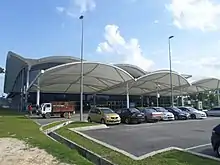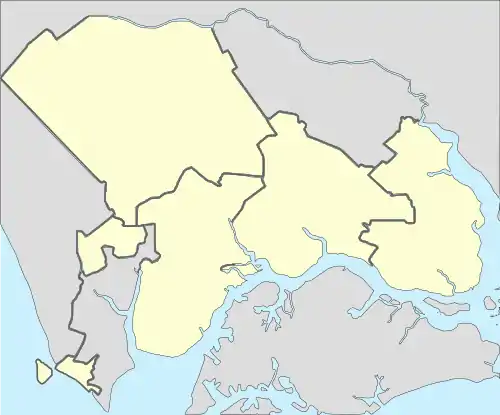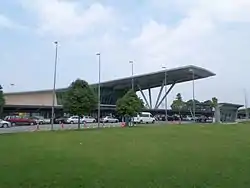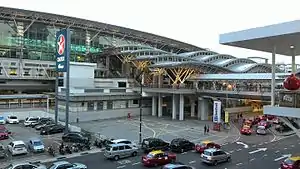Iskandar Malaysia
Iskandar Malaysia (IM; Jawi: إسکندر مليسيا), formerly known as Iskandar Development Region (IDR; Malay: Wilayah Pembangunan Iskandar; Jawi: ولايه ڤمباڠونن إسکندر) and South Johor Economic Region (SJER), is the main southern development corridor in Johor, Malaysia. It was established on 8 November 2006.[2]
Iskandar Malaysia
إسکندر مليسيا | |
|---|---|
Development Corridor | |
 | |
 Flag | |
| Country | Malaysia |
| State | Johor |
| Region | Johor Bahru District Kulai District Pontian District Kota Tinggi District Kluang District |
| Population (2013) | |
| • Total | 1.805 million[1] |
| Time zone | UTC+8 (Malaysian Standard Time) |
| • Summer (DST) | not applicable |
| Postcode | 79xxx-82xxx, 86xxx |
| Area code(s) | +607 (07-2, 07-3, 07-5, 07-6, 07-7 and 07-8) |
| Website | iskandarmalaysia.com.my |
Iskandar Malaysia's development is guided by the Comprehensive Development Plan (CDP) and the Circle of Sustainability, ensuring that the region grows holistically into a prosperous economy with a high-quality living ecosystem and a resilient environment.
Iskandar Malaysia's generous land area, strategic location and abundant ready infrastructure boosted its 9 promoted sectors which are Electrical & Electronics, Petrochemical and Oleo-Chemical, Food & Agro-Processing, Logistics, Tourism, Creative, Healthcare and Financial.
With a target of 3 million population and RM383 billion in cumulative investment by 2025, the thriving economic environment is complemented by the growth in the social and environmental facets.
Environmentally, the development of Iskandar Malaysia is through a Green-focused Agenda, whereby a green and sustainable environment is one of the main agenda. ‘Iskandar Malaysia Low Carbon Society Blueprint’ is acknowledged locally and globally and has driven many stakeholders in the region to adopt various green programmes and initiatives that benefit the businesses and community.
Iskandar Malaysia is also developed to be a Smart City which encompasses the 6 dimensions of Smart Economy, Smart Governance, Smart Environment, Smart Mobility, Smart People and Smart Living and, is proud of its achievement in the creation of this pilot program for Smart cities across Malaysia and the region.
The development of Iskandar Malaysia is planned, promoted and facilitated by Iskandar Regional Development Authority.
History
The special economic zone of Iskandar Malaysia grew out of a 2005 government requested feasibility study by the Khazanah Nasional which found that the development of such a zone would be economically, socially and developmentally beneficial.[3] The National SJER Planning Committee (NSPC), hearing Khazanah's findings, put it in charge of developing a sustainable, holistic approach to development in the region.[3] Iskandar Malaysia was singled out as among the high-impact developments of the Ninth Malaysia Plan, put into action by the then Prime Minister of Malaysia (Abdullah Badawi) in March 2006 to cover the period of 2006 to 2010.[4] In November 2006, the Prime Minister, Chief Minister of Johor, Abdul Ghani Othman and Khazanah revealed the Comprehensive Development Plan (CDP).
Area
The development region encompasses an area of 4,749 km2 covering Johor Bahru District, Kulai District and part of Pontian District. 5 local government authorities have jurisdiction over the covered area, including Johor Bahru City Council, Iskandar Puteri City Council, Pasir Gudang City Council, Kulai Municipal Council, Pontian District Council.
The population of Iskandar Malaysia is slightly over 2 million in 2020.
Comprehensive Development Plan
Physical Development Plan
The Physical Development Plan (PDP) was designed to guide the development of land within Iskandar Malaysia to help promote the CDP's overall goals of economic development and quality of life. To that end, the CDP includes two major subdivisions among land zones, "Basic Zoning Districts" and "Special Overlay Zones".
There are several dozen primary "Basic Zoning Districts" governing the use of land in commercial, residential, industrial and other sectors, including determining the density of development and what mixed-use may or may not be allowed.[5] Also governed by the "Basic Zoning Districts" are such special use zones as green space, wetlands, cemeteries and governmental developments.
"Special Overlay Zones" are areas that require exceptional treatment. For example, the "Johor Bahru CBD" allows exceptions to general commercial plot ratio and height because the zone is the commercial and financial centre of Iskandar Malaysia and the capital city of Johor. Similarly, the "Iskandar Puteri Central Planning Area" is given special handling. Other "Special Overlay Zones" cover environmentally sensitive areas, historic areas, coastland, development around highways and rail stations and the "Water Catchment Zone" around the Sultan Iskandar Dam.
Commercial development
The commercial focus of the CDP is on six services identified as "pillars", including creative, educational, financial, healthcare, logistics and tourism. The CDP included the establishment of the Iskandar Investment Berhad, a commercial investment holding company created to oversee and encourage regional development.[6] The CDP promotes the "Strategic Catalyst Development" goals of developing waterfront areas, promoting tourism, expanding healthcare and iconic areas, and mixing commercial and residential development.
It also incorporates a "Business Incentives and Support Package" (ISP) discussed by Prime Minister Badawi on 22 March 2007 which allows special incentives to encourage investment in certain concentrated hubs in the flagship zones. The specific zones involved were revealed in October 2007 and at that time included only Medini Iskandar Malaysia, which is a mixed-development zone incorporating leisure, residential, financial and high-end industrial components. Incentives include tax exemptions for qualifying companies for income from qualifying activities,[7] exemption from Foreign Investment Committee rules, and flexibilities under the foreign exchange administration rules, including those restricting the numbers of "foreign knowledge workers".
Doubling sizes
On 22 February 2019, Iskandar Malaysia will growth corridor which doubled in size and will include at least two new districts which is Kluang and Kota Tinggi. The region was 2,217 sq/km previously and will cover an area of 4,749 sq/km, which includes parts of Kota Tinggi, Kluang and Pontian.[8]
Major projects 2006-2025
- Iskandar Coastal Highway
- Johor Bahru East Coast Highway
- Johor Bahru Eastern Dispersal Link Expressway
- Johor Premium Outlets
- Kota Iskandar
- Larkin Sentral
- Legoland Malaysia Resort
- Senai–Desaru Expressway
- Asia Petroleum Hub
- Tanjung Bin
- Southern Gateway CIQ
- Iskandar Puteri HSR
- Johor Bahru–Singapore Rapid Transit System
- RAPID Pengerang Refinery
- Forest City
- Princess Cove
- Ibrahim International Business District IIBD
- Desaru Coast
- Puteri Harbour
- Iskandar Sentral
- Southkey Mall
- Gerbang Nusajaya
- Educity
- Sunway Iskandar
Transportation
Air
The region is served by Senai International Airport which is located in Senai.[9] Six airlines, AirAsia, Firefly, Malaysia Airlines, Malindo Air , Jin Air and Xpress Air, provide flights internationally and domestically.[10]
Train
The region consists of Johor Bahru Sentral, Kempas Baru and Kulai Station.[11][12]
Sea

For cargo ports, the region consists of Johor Port in Pasir Gudang and Port of Tanjung Pelepas in Iskandar Puteri.[13]
For passenger service boats, the region consists of Johor Bahru International Ferry Terminal in Stulang, Johor Bahru, Kukup International Ferry Terminal in Kukup, Pontian District, Pasir Gudang Ferry Terminal in Pasir Gudang and Puteri Harbour International Ferry Terminal in Kota Iskandar, Iskandar Puteri.[9]
Road

Iskandar Puteri houses Gelang Patah, GP Sentral, Kota Iskandar, Taman U, Taman Ungku Tun Aminah terminals. Johor Bahru houses JB Sentral, Larkin Sentral, Taman Johor Jaya and Ulu Tiram terminals. Kulai houses Kulai terminal. Pasir Gudang houses Masai and Pasir Gudang terminal. Pontian houses Pontian Public Transportation terminal.[14] Grab operates in the city.[15] and GrabTaxi.[16]
The internal roads linking different parts of the region are mostly federal roads constructed and maintained by Malaysian Public Works Department. The five major highways linking the Johor Bahru Central Business District to outlying suburbs are Tebrau Highway and Johor Bahru Eastern Dispersal Link Expressway in the northeast, Skudai Highway in the northwest, Iskandar Coastal Highway in the west and Johor Bahru East Coast Highway in the east.[17] Pasir Gudang Highway and the connecting Johor Bahru Parkway cross Tebrau Highway and Skudai Highway, which serve as the middle ring road of the metropolitan area. The Johor Bahru Inner Ring Road aids in controlling the traffic around the city center of Johor Bahru.[17] Access to the national expressway is provided through the North–South Expressway and Senai–Desaru Expressway. The Johor–Singapore Causeway links the city to Woodlands, Singapore with a six-lane road and a railway line terminating at the Southern Integrated Gateway.[17] The Malaysia–Singapore Second Link, located west of the metropolitan area, was constructed in 1997 to alleviate congestion on the Causeway. It is linked directly to the Second Link Expressway, Johor Bahru Parkway, the railway station, and the North–South Expressway.[9] Further expansion of other major highways in the city were currently in the process.[18]
See also
References
- "Iskandar Malaysia Key Economic Statistics". Iskandar Regional Development Authority. Iskandar Malaysia. Archived from the original on 2 December 2014. Retrieved 26 July 2015.
- New township planned for Malaysia's Iskandar economic zone, Richard High, 4 July 2008, KHL Group
- Iskandar Regional Development Authority & Iskandar Malaysia Information Pack, 23 February 2007, Khazanah Nasional, pg 3, retrieved 3 March 2009
- Rancangan Malaysia Kesembilan, Ministry of Information Malaysia, retrieved 4 March 2009
- Free Access Zone under IDR scrapped, MEERA VIJAYAN, 5 April 2007, The Star (Malaysia)
- Iskandar Regional Development Authority & Iskandar Malaysia Information Pack, 23 February 2007, Khazanah Nasional, pg 4, retrieved 3 March 2009
- IRDA Announces 10 Year Tax Relief For Developers In Node 1 of Iskandar Development Region, Iskandar Malaysia, 9 October 2007, Malaysia
- "Iskandar Malaysia growth corridor doubles in size". Retrieved 22 February 2019.
- Simon Richmond; Damian Harper (December 2006). Malaysia, Singapore & Brunei. Ediz. Inglese. Lonely Planet. pp. 247–253. ISBN 978-1-74059-708-1.
- "Malaysia's new airline in $1.5bn deal with Bombardier". BBC News. 18 March 2015. Retrieved 17 August 2015.
- "From Singapore to KL by train". The Malaysia Site. Archived from the original on 28 July 2015. Retrieved 29 July 2015.
- "Singapore to Malaysia in just 5 minutes? It's now possible". The Straits Times/Asia News Network. Philippine Daily Inquirer. 5 July 2015. Archived from the original on 20 August 2015. Retrieved 20 August 2015.
- "Profit From Malaysia's Petrochemical Industry (Pasir Gudang-Tanjung Langsat, Johor)" (PDF). Malaysian Industrial Development Authority. 2011. p. 6. Archived from the original (PDF) on 29 July 2015. Retrieved 29 July 2015.
- "Larkin Bus Terminal". Express Bus Malaysia. Archived from the original on 28 July 2015. Retrieved 29 July 2015.
- Daniel Tay (22 August 2014). "Uber secretly arrives in Johor Bahru with free rides in hand". Tech in Asia. Archived from the original on 20 August 2015. Retrieved 20 August 2015.
- Steven Loeb (1 July 2015). "GrabTaxi raises $200M, now valued at $1.5B". Vator. Archived from the original on 20 August 2015. Retrieved 20 August 2015.
- "Flagship A: Johor Bahru City". Iskandar Regional Development Authority. Iskandar Malaysia. Archived from the original on 27 July 2015. Retrieved 27 July 2015.
- "Chapter 15: Urban Linkage System (Section B: Planning and Implementation)" (PDF). Iskandar Malaysia. Archived from the original (PDF) on 28 July 2015. Retrieved 28 July 2015.


